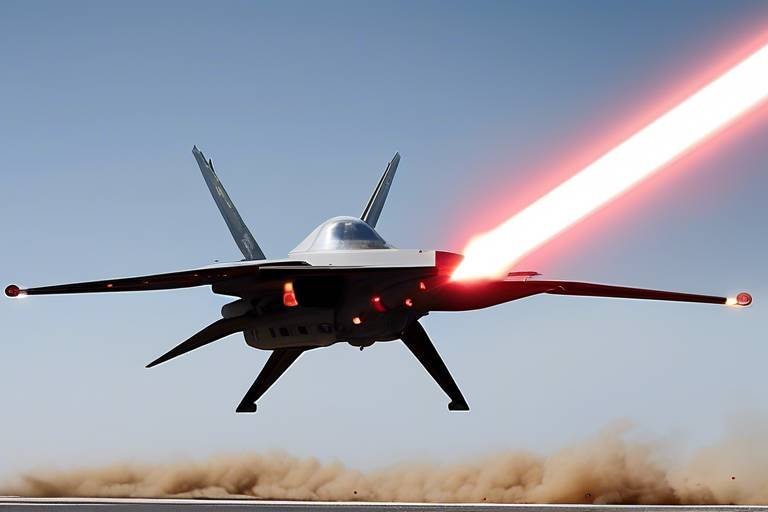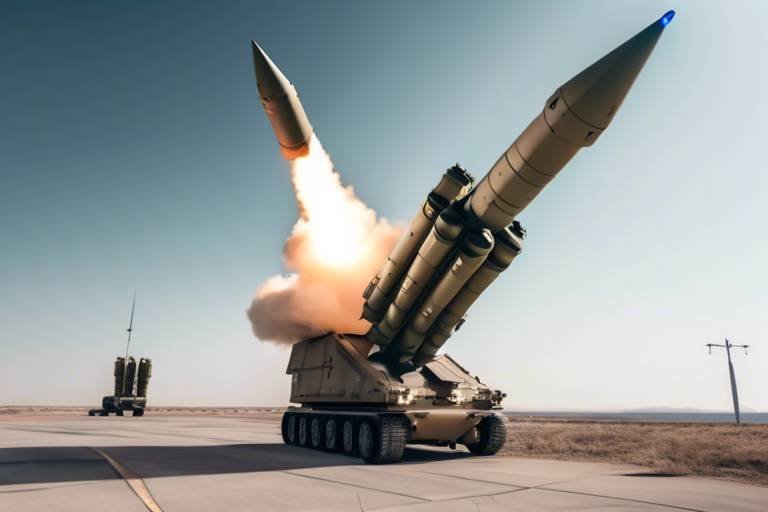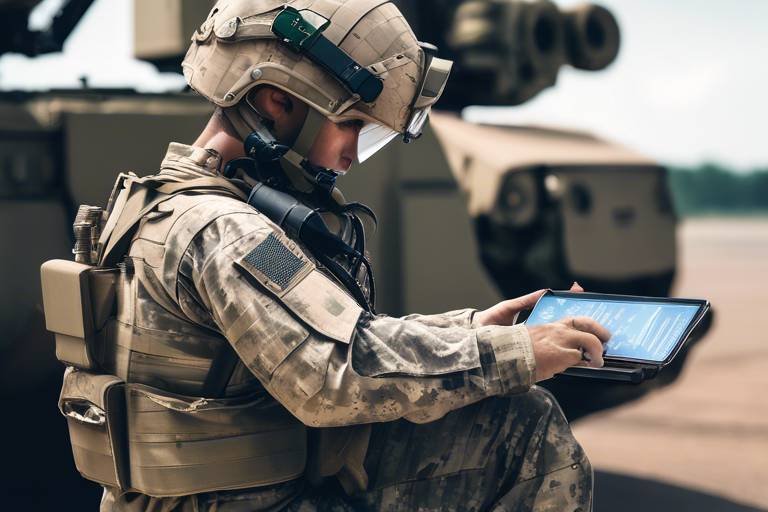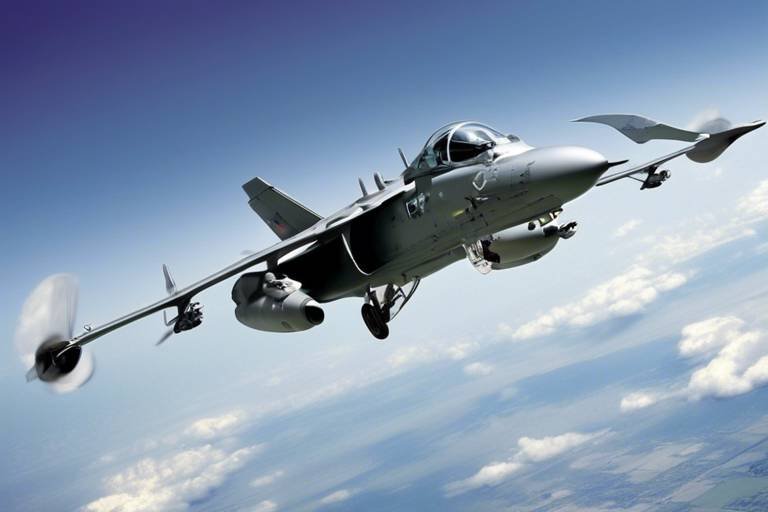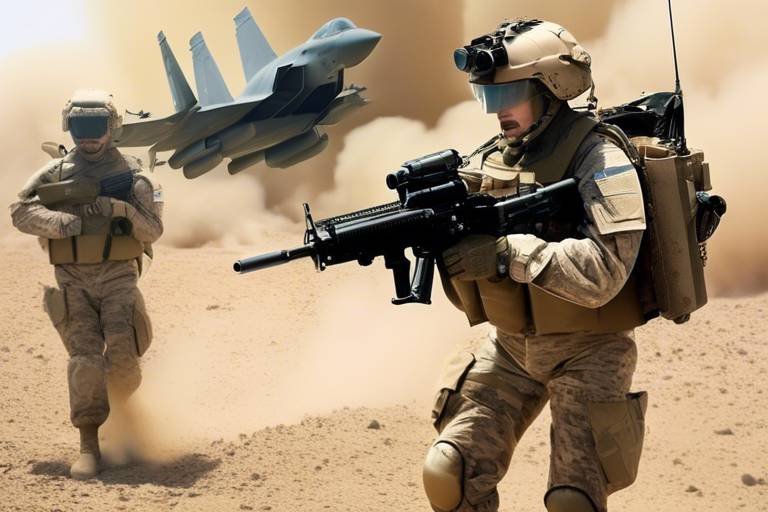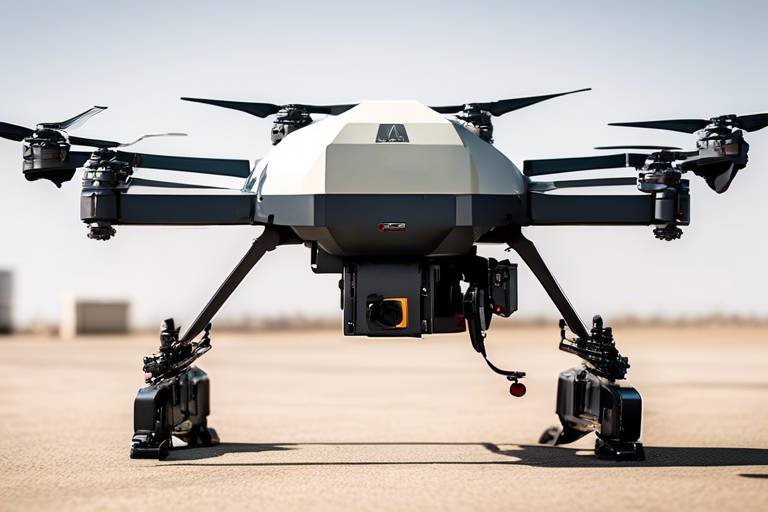How AI is Enhancing Military Asset Management
In today's fast-paced world, the integration of artificial intelligence (AI) into military operations is not just a trend; it's a revolution. Imagine a battlefield where every asset is tracked in real-time, where decisions are made based on predictive analytics, and where logistical nightmares are transformed into seamless operations. This is the new era of military asset management, where AI plays a pivotal role in enhancing efficiency, effectiveness, and security.
From the way inventory is managed to the optimization of logistics and maintenance, AI is changing the game. It's like having a supercharged brain that can process vast amounts of data and predict outcomes faster than any human could. This article delves into the transformative role of AI in military asset management, exploring its benefits, challenges, and future implications for defense operations and logistics.
One of the most significant advantages of AI in military asset management is its ability to streamline inventory processes. Think about it: military operations require a plethora of supplies, from ammunition to medical kits. AI technologies can predict supply needs by analyzing historical data and current trends. This predictive capability ensures that military assets are always available when needed, without the risk of overstocking or running short on critical supplies. By optimizing stock levels and reducing waste, AI not only saves money but also enhances operational readiness.
Imagine a world where military equipment rarely fails. AI-driven predictive maintenance techniques make this a reality by analyzing data from various sources, such as sensors embedded in equipment. These systems can foresee potential failures before they happen, allowing for timely repairs and minimizing downtime. This proactive approach enhances operational readiness and ensures that military personnel have access to fully functional assets when they need them the most.
Logistics can often be a logistical nightmare, especially in military operations where timing and precision are crucial. AI algorithms can analyze complex logistics networks to optimize routes and delivery schedules. This means that military supplies are transported efficiently and effectively to the right locations at the right times. By reducing transportation costs and improving delivery times, AI not only enhances operational efficiency but also ensures that troops have what they need, when they need it.
In the military, making quick and informed decisions can mean the difference between success and failure. AI systems process vast amounts of data to provide actionable insights, enabling military leaders to make informed decisions quickly and accurately in dynamic operational environments. It’s akin to having a skilled advisor who can sift through mountains of information and highlight the most critical data points, allowing commanders to focus on what truly matters.
Training is essential in the military, and AI technologies are revolutionizing how personnel prepare for real-world scenarios. By creating realistic training simulations, AI helps improve preparedness and decision-making skills. These immersive environments replicate actual battlefield conditions, allowing soldiers to practice their responses and strategies without the risks associated with live training. This means better-trained soldiers who are ready for anything.
In an increasingly digital world, cybersecurity is paramount, especially for military assets. AI plays a crucial role in enhancing cybersecurity by detecting anomalies and potential threats in real-time. This proactive approach safeguards sensitive information and operational integrity, ensuring that military operations can proceed without the looming threat of cyberattacks. It's like having a vigilant guard who never sleeps, always on the lookout for potential breaches.
AI applications assist in optimizing resource allocation by analyzing mission requirements and available assets. This ensures that military operations are conducted with maximum efficiency and effectiveness. By evaluating various factors, including troop movements and equipment availability, AI helps commanders allocate resources in a way that maximizes impact and minimizes waste.
Integrating AI into strategic planning processes enables military organizations to evaluate various scenarios and outcomes. This capability improves long-term planning and resource management, allowing military leaders to anticipate challenges and prepare accordingly. It’s like having a crystal ball that provides insights into the future, helping organizations navigate complex operational landscapes.
As technology continues to evolve, the future of AI in military asset management promises advancements that will further enhance efficiency, effectiveness, and security in defense operations. From autonomous systems to advanced analytics, the potential applications of AI are vast and varied. The military is on the cusp of a new frontier, where AI will play an even more integral role in shaping the future of warfare and defense strategies.
- What is AI in military asset management?
AI in military asset management refers to the use of artificial intelligence technologies to improve the efficiency and effectiveness of managing military resources, including equipment, supplies, and personnel. - How does AI improve inventory management?
AI enhances inventory management by predicting supply needs, optimizing stock levels, and reducing waste, ensuring that military assets are available when needed. - What role does AI play in predictive maintenance?
AI analyzes data from military equipment to foresee potential failures, allowing for timely repairs and minimizing downtime. - Can AI help with logistics in the military?
Yes, AI algorithms optimize logistics by analyzing complex networks to improve routes and delivery schedules, ensuring efficient transportation of supplies.

Improving Inventory Management
In the fast-paced world of military operations, effective inventory management is absolutely crucial. Imagine a scenario where a battalion is in dire need of supplies, but due to poor tracking and outdated systems, those supplies are nowhere to be found. This is where artificial intelligence steps in, revolutionizing the way military organizations handle their assets. By leveraging AI technologies, military forces can streamline their inventory processes, ensuring that essential items are always available when needed. This is not just about having enough supplies; it's about having the right supplies at the right time.
One of the most significant advantages of AI in inventory management is its ability to predict supply needs with remarkable accuracy. By analyzing historical data, consumption patterns, and even external factors like weather conditions or operational tempo, AI can forecast what items will be required in the near future. This predictive capability allows military logistics teams to optimize stock levels, reducing waste and preventing costly overstocking. For instance, if a particular unit tends to use more medical supplies during certain operations, AI can alert the supply chain managers ahead of time, enabling them to prepare accordingly.
Moreover, AI-driven systems can continuously monitor inventory levels in real-time. This means that if supplies dip below a certain threshold, automated alerts can be triggered, prompting immediate restocking actions. Such proactive measures not only enhance operational readiness but also contribute to significant cost savings. With traditional methods, inventory management often involved manual checks and estimates, leading to discrepancies and inefficiencies. AI eliminates much of this guesswork, providing a clear and accurate picture of what is available and what is needed.
Additionally, AI can help in categorizing and prioritizing inventory based on various criteria, such as the urgency of need or the criticality of the items. For example, high-demand items like ammunition or spare parts for essential equipment can be flagged for priority restocking, ensuring that frontline units are never left wanting. This prioritization is vital in military operations where every second counts and the margin for error is slim.
To illustrate the impact of AI on inventory management, consider the following table that highlights some key benefits:
| Benefit | Description |
|---|---|
| Predictive Analytics | Forecasts supply needs based on historical data and trends. |
| Real-Time Monitoring | Continuously tracks inventory levels and triggers alerts for restocking. |
| Cost Efficiency | Reduces waste and prevents overstocking, leading to significant savings. |
| Prioritization | Flags critical items for immediate restocking based on urgency. |
In conclusion, the integration of AI into military inventory management is a game-changer. It not only enhances efficiency but also ensures that military personnel are equipped with the necessary resources to perform their duties effectively. As technology continues to evolve, we can expect even more sophisticated solutions that will further transform the landscape of military logistics.
- How does AI predict supply needs? AI uses historical data, consumption patterns, and external factors to forecast future requirements.
- Can AI help reduce costs in inventory management? Yes, by minimizing waste and preventing overstocking, AI contributes to significant cost savings.
- Is real-time monitoring essential for military operations? Absolutely! Real-time monitoring ensures that supplies are always available when needed, enhancing operational readiness.

Predictive Maintenance
The concept of is revolutionizing how military organizations manage their assets. Imagine having the ability to foresee equipment failures before they happen, much like a weather forecast that predicts a storm. This capability is made possible through the use of advanced artificial intelligence (AI) technologies that analyze vast amounts of data collected from various military equipment. By utilizing sensors and data analytics, AI systems can detect patterns and anomalies that indicate potential issues, allowing for timely interventions.
One of the most significant benefits of predictive maintenance is its ability to enhance operational readiness. Equipment downtime can be detrimental in military operations, where every second counts. With AI-driven predictive maintenance, maintenance teams can schedule repairs during non-operational hours, ensuring that assets are always in peak condition when needed. This proactive approach not only minimizes unexpected failures but also extends the lifespan of military equipment, ultimately saving costs in the long run.
To illustrate the effectiveness of predictive maintenance, consider the following table that outlines the comparison between traditional maintenance methods and AI-driven predictive maintenance:
| Aspect | Traditional Maintenance | Predictive Maintenance |
|---|---|---|
| Approach | Reactive; repairs made after failure | Proactive; repairs based on data analysis |
| Downtime | Unpredictable; can lead to mission delays | Minimized; scheduled repairs reduce impact |
| Cost | Higher long-term costs due to emergencies | Lower costs through optimized maintenance |
| Equipment Lifespan | Shorter due to unaddressed issues | Longer due to timely interventions |
Moreover, the integration of AI in predictive maintenance fosters a culture of data-driven decision-making. Maintenance personnel can rely on real-time analytics to prioritize tasks, ensuring that the most critical equipment is serviced first. This not only streamlines operations but also enhances the overall efficiency of military logistics. As military operations become increasingly complex, the ability to make informed decisions based on accurate data is invaluable.
In conclusion, predictive maintenance powered by AI is not just a trend; it is a necessity in modern military asset management. By anticipating failures, optimizing maintenance schedules, and extending equipment lifespans, military organizations can maintain their operational edge. As we continue to embrace these technological advancements, the future of military readiness looks brighter than ever.
- What is predictive maintenance? Predictive maintenance is a proactive approach that uses data analytics to predict when equipment failures might occur, allowing for timely repairs.
- How does AI contribute to predictive maintenance? AI analyzes data from sensors and equipment to identify patterns that indicate potential failures, enabling maintenance teams to act before issues arise.
- What are the benefits of predictive maintenance in the military? Benefits include reduced downtime, cost savings, extended equipment lifespan, and enhanced operational readiness.
- Can predictive maintenance be applied to all types of military equipment? Yes, predictive maintenance can be applied to various types of military assets, including vehicles, aircraft, and communication systems.

Logistics Optimization
In the fast-paced world of military operations, is not just a luxury; it's a necessity. Imagine a vast chessboard where every piece must move in perfect harmony to achieve victory. That's what logistics is like for the military—every supply, every troop movement, and every piece of equipment must be synchronized to ensure success. With the integration of artificial intelligence (AI), this synchronization has reached unprecedented levels. AI algorithms are now capable of analyzing complex logistics networks, which allows military planners to optimize routes and delivery schedules like never before.
Think about it: traditional logistics methods often relied on intuition and experience, which, while valuable, could lead to inefficiencies. With AI, we can harness the power of data. For example, AI can process vast amounts of information from various sources, including weather patterns, road conditions, and even enemy movements. This data-driven approach enables military leaders to make informed decisions in real-time, ensuring that supplies are transported efficiently and effectively to the right locations at the right times.
One of the key benefits of AI in logistics optimization is its ability to foresee potential bottlenecks before they occur. By analyzing historical data and current trends, AI can predict where delays might happen and suggest alternative routes or methods of transportation. This proactive approach not only saves time but also minimizes costs. For instance, if a particular route is likely to be congested due to construction or weather, AI can reroute supplies to ensure they arrive on schedule.
Moreover, AI can also enhance the decision-making process by providing a comprehensive view of the entire supply chain. This means military leaders can see not just where supplies are at any given moment, but also how they are being utilized. This transparency allows for better resource allocation and reduces waste. Consider a scenario where certain equipment is overstocked while critical supplies are running low. AI can highlight these discrepancies, enabling quick adjustments to inventory levels.
To illustrate the impact of AI on logistics optimization, let's look at a simple table that summarizes the traditional logistics approach versus an AI-enhanced approach:
| Aspect | Traditional Logistics | AI-Enhanced Logistics |
|---|---|---|
| Data Processing | Manual and time-consuming | Real-time and automated |
| Decision Making | Experience-based | Data-driven insights |
| Route Optimization | Static and inflexible | Dynamic and adaptable |
| Bottleneck Prediction | Reactive | Proactive |
As we look to the future, the implications of AI in logistics optimization are enormous. With the ability to constantly learn and adapt, AI can refine its algorithms based on new data, ensuring that military logistics remain agile and responsive to changing circumstances. The potential for enhanced efficiency and effectiveness in military operations cannot be overstated. As we continue to explore these advancements, one thing is clear: AI is revolutionizing the way we think about logistics in the military, paving the way for a more strategic and informed approach to asset management.
- How does AI improve logistics in the military? AI enhances logistics by analyzing data to optimize routes, predict bottlenecks, and improve decision-making processes.
- What are the benefits of using AI in military logistics? Key benefits include increased efficiency, reduced costs, and enhanced operational readiness through real-time data analysis.
- Can AI predict supply chain disruptions? Yes, AI can analyze historical and current data to foresee potential disruptions and suggest alternative solutions.

Data Analysis and Decision Making
In today's rapidly changing battlefield, the ability to make quick and informed decisions is paramount. This is where artificial intelligence (AI) comes into play, revolutionizing the way military leaders analyze data and make decisions. Imagine a vast ocean of information—intelligence reports, logistics data, troop movements, and equipment status. Sorting through this data manually would be like searching for a needle in a haystack. Thankfully, AI acts as a powerful magnet, pulling out the most relevant insights that can guide military operations.
AI systems are designed to process enormous amounts of data in real-time, identifying patterns and trends that the human eye might miss. For instance, consider a scenario where a military unit is deployed in a conflict zone. AI can analyze historical data, current conditions, and enemy movements to forecast potential threats and opportunities. This allows commanders to make decisions based on predictive analytics rather than gut feelings, which is a game-changer in high-stakes environments.
Moreover, AI enhances decision-making by providing actionable insights that are tailored to specific operational needs. By utilizing advanced algorithms, AI can evaluate multiple scenarios simultaneously, helping military leaders to weigh the pros and cons of different strategies. For example, a military planner could use AI to simulate various outcomes based on troop deployments, resource allocations, and potential enemy actions. This not only saves time but also reduces the risks associated with decision-making in volatile situations.
To illustrate the impact of AI on decision-making, let’s take a look at a simplified example of how AI can transform data analysis:
| Data Type | Traditional Analysis | AI-Driven Analysis |
|---|---|---|
| Intelligence Reports | Manual review and interpretation | Automated extraction of key insights |
| Logistics Data | Static reporting | Dynamic real-time updates |
| Troop Movements | Human analysis | Predictive modeling of enemy responses |
This table demonstrates how AI can streamline the analysis process, making it faster and more accurate. By automating routine tasks, military personnel can focus on strategic thinking and planning, rather than getting bogged down in data collection and interpretation. In essence, AI acts as a force multiplier, enhancing the capabilities of military leaders.
However, it's important to note that while AI significantly boosts decision-making efficiency, it should not replace human judgment. The best outcomes occur when AI and human intelligence work hand in hand. Military leaders bring invaluable experience and intuition to the table, which, when combined with AI's analytical prowess, can lead to superior decision-making. This synergy between human insight and AI-driven data analysis is what will ultimately shape the future of military operations.
As we move forward, the integration of AI into military decision-making processes will only deepen. With advancements in machine learning and data analytics, we can expect even more sophisticated tools that will help military leaders navigate complex operational landscapes. The future is bright, and the potential for AI to enhance decision-making in the military is as vast as the data it processes.
- How does AI improve military decision-making? AI enhances decision-making by processing large volumes of data quickly, identifying patterns, and providing actionable insights that help military leaders make informed choices.
- Can AI replace human judgment in military operations? No, AI should complement human judgment rather than replace it. The best decisions come from a synergy between AI analytics and human experience.
- What are some examples of AI applications in military data analysis? Examples include predictive analytics for troop movements, real-time logistics updates, and automated intelligence report analysis.

Enhanced Training Simulations
When it comes to military training, the stakes couldn't be higher. Imagine soldiers preparing for real-life combat scenarios without ever stepping foot on a battlefield. Artificial Intelligence (AI) is revolutionizing this aspect of military readiness through . These simulations are not just computer-generated images; they are immersive experiences that replicate the chaos and unpredictability of actual combat situations.
By utilizing advanced algorithms and machine learning, AI can create realistic environments that adapt to the actions and decisions of the trainees. This means that no two training sessions are ever the same, keeping soldiers on their toes and prepared for whatever challenges they may face. For example, if a soldier makes a tactical error during a simulation, the AI can adjust the scenario in real-time, introducing new variables that mimic the consequences of that mistake. This kind of dynamic training allows military personnel to learn and adapt swiftly, honing their skills in a safe yet challenging environment.
Moreover, these AI-driven simulations can be tailored to meet the specific needs of different units or missions. Whether it's urban warfare, reconnaissance, or logistics management, the training can be customized to reflect the unique challenges each unit may encounter. This level of personalization ensures that every soldier receives the most relevant training, enhancing their preparedness and decision-making capabilities.
One of the most exciting aspects of AI-enhanced training is its ability to collect and analyze performance data. After each simulation, instructors can review detailed analytics that show how each soldier performed, what decisions they made, and where they struggled. This data-driven approach allows for targeted feedback and improvement, ensuring that training is not just a routine but a continuous learning process. In essence, it's like having a coach who is constantly evaluating and refining your skills, pushing you to be your best.
Additionally, AI can facilitate collaborative training exercises, where multiple units can engage in joint simulations. This fosters teamwork and coordination among different branches of the military, which is crucial for success in real-world operations. By practicing together in a simulated environment, soldiers can develop a deeper understanding of each other's roles and improve their ability to work as a cohesive unit.
In summary, AI is not just enhancing training simulations; it's transforming the entire approach to military preparation. With its ability to create realistic, adaptive, and data-driven training experiences, AI ensures that military personnel are not only ready for the battlefield but are also equipped with the skills and knowledge necessary to succeed in complex, high-pressure situations. As technology continues to evolve, the future of military training looks increasingly promising, paving the way for a new era of preparedness and effectiveness.
- How do AI-enhanced training simulations work?
AI algorithms create realistic environments that adapt based on the trainees' actions, providing a dynamic and immersive training experience. - What are the benefits of using AI in military training?
AI enhances realism, personalizes training, provides detailed performance analytics, and fosters collaboration among units. - Can AI simulations replace traditional training methods?
While AI simulations are a powerful tool, they are designed to complement traditional training methods, not replace them entirely.

Cybersecurity Measures
In the ever-evolving landscape of military operations, cybersecurity has emerged as a critical component of asset management. With the increasing reliance on technology, military assets are vulnerable to a myriad of cyber threats that could compromise sensitive information and operational integrity. The integration of artificial intelligence in cybersecurity measures is revolutionizing how military organizations protect their assets. AI systems are capable of analyzing vast amounts of data in real-time, identifying patterns that may indicate potential threats, and responding to them more swiftly than traditional methods. This proactive approach is essential for maintaining the security of military operations.
One of the most significant advantages of using AI in cybersecurity is its ability to detect anomalies. For instance, when a soldier accesses data that is outside their usual parameters, AI can flag this activity for further investigation. This capability is akin to having a vigilant guard who never sleeps, constantly monitoring for unusual behavior. Moreover, AI can learn from previous incidents, continuously improving its detection algorithms and adapting to new threats as they arise. This adaptive learning ensures that military forces stay one step ahead of cyber adversaries.
Furthermore, AI-driven cybersecurity measures can automate responses to threats, significantly reducing the time it takes to neutralize potential risks. Imagine a scenario where a cyberattack is detected; AI systems can immediately initiate countermeasures, such as isolating affected systems or rerouting data traffic, all without human intervention. This rapid response capability is crucial in high-stakes environments where every second counts. Additionally, AI can assist in conducting thorough risk assessments, evaluating the vulnerabilities of various military assets and recommending enhancements to fortify defenses.
However, the implementation of AI in cybersecurity is not without its challenges. As military organizations embrace these advanced technologies, they must also contend with the potential for AI systems to be manipulated by adversaries. Cybersecurity measures must be robust enough to withstand attacks that aim to exploit AI vulnerabilities. This necessitates a dual approach: not only must military forces invest in cutting-edge AI technologies, but they must also ensure that their cybersecurity frameworks are fortified against potential exploitation.
In summary, the role of AI in enhancing cybersecurity measures for military assets cannot be overstated. By providing real-time threat detection, automated responses, and continuous learning capabilities, AI is transforming the way military organizations protect their critical information and operational integrity. As we look to the future, it is clear that the integration of AI in cybersecurity will play a pivotal role in safeguarding military assets against the ever-growing threat of cyber warfare.
- How does AI improve military cybersecurity?
AI enhances military cybersecurity by providing real-time threat detection, automating responses to potential risks, and continuously learning from past incidents to adapt to new threats. - What are the challenges of implementing AI in military cybersecurity?
The challenges include the potential for AI systems to be manipulated by adversaries and the need for robust cybersecurity frameworks to withstand such attacks. - Can AI respond to cyber threats without human intervention?
Yes, AI systems can automate responses to detected threats, allowing for immediate action to neutralize risks without waiting for human input.
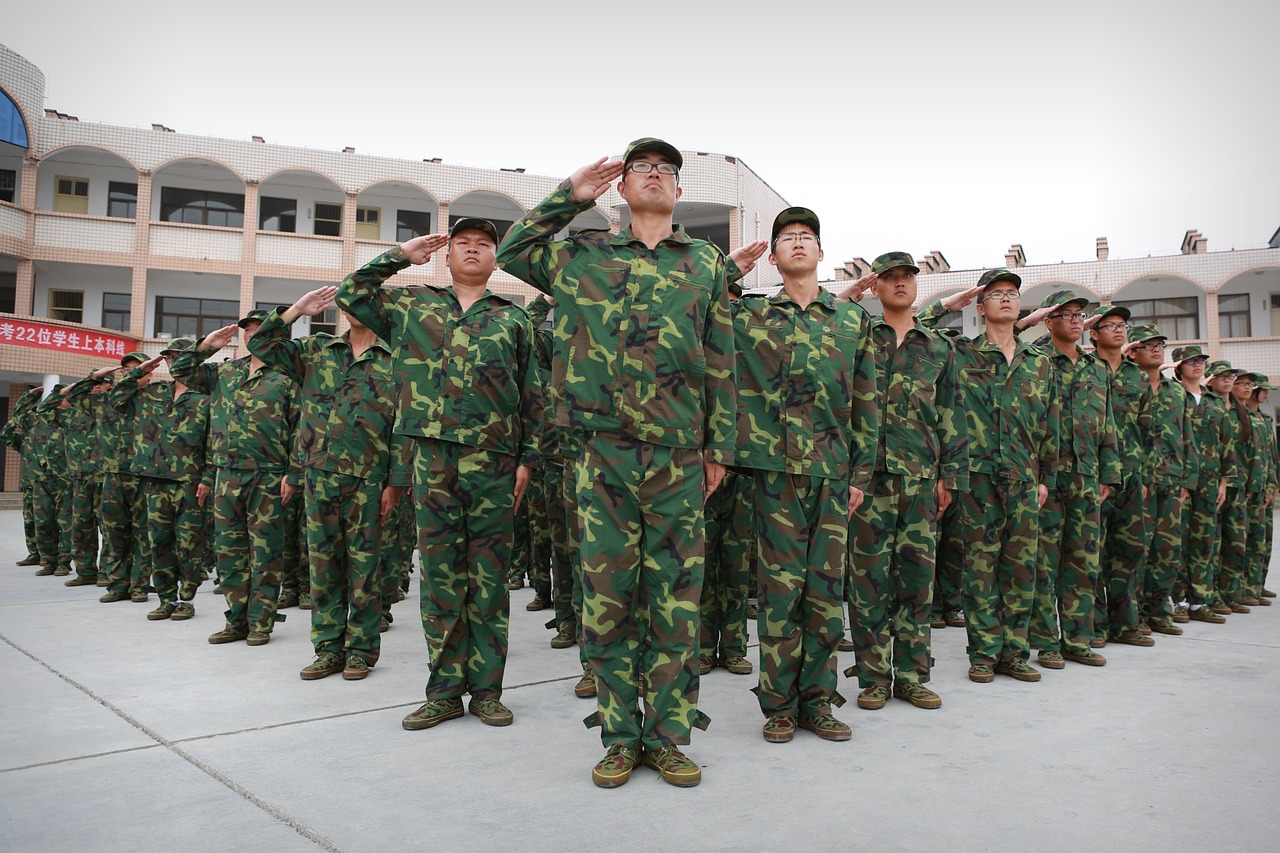
Resource Allocation Efficiency
In the ever-evolving landscape of military operations, has become a critical factor in achieving mission success. With the advent of artificial intelligence (AI), military organizations are now leveraging advanced algorithms and data analytics to optimize how resources are allocated across various missions. Imagine a chess game where each piece is a vital asset, and the AI acts as a grandmaster, predicting the best moves to ensure victory. This is how AI transforms resource management in the military, making it more strategic and effective.
One of the most remarkable aspects of AI in resource allocation is its ability to analyze vast amounts of data in real-time. By considering various factors such as troop movements, supply chain logistics, and mission requirements, AI systems can provide military leaders with actionable insights that enhance decision-making. For instance, when planning a deployment, AI can assess current asset availability, predict future needs based on historical data, and suggest the most efficient distribution of resources.
Moreover, AI-driven systems can also take into account environmental conditions, geopolitical factors, and even the morale of troops. This holistic approach ensures that resources are not only allocated efficiently but also effectively, maximizing their impact on mission outcomes. For example, if a particular region is experiencing adverse weather conditions, AI can recommend reallocating assets to ensure that operations continue smoothly elsewhere, thus maintaining operational readiness.
To illustrate the impact of AI on resource allocation, let's consider a hypothetical scenario where a military unit is preparing for a large-scale operation. The following table outlines how AI can streamline the allocation process:
| Resource Type | Current Availability | Predicted Requirement | AI Recommendation |
|---|---|---|---|
| Troops | 500 | 600 | Reassign 100 troops from nearby base |
| Vehicles | 150 | 200 | Request additional vehicles from logistics |
| Supplies | 75% | 90% | Increase supply shipment by 20% |
This table demonstrates how AI can quickly assess the gaps in resource availability and provide recommendations to fill those gaps, ensuring that military operations run smoothly. By doing so, military leaders can focus on strategy and execution rather than getting bogged down in logistical challenges.
Furthermore, AI's predictive capabilities extend beyond immediate operations. By analyzing historical data and trends, AI can forecast future resource needs, allowing military organizations to plan better and allocate budgets more effectively. This forward-thinking approach not only enhances operational efficiency but also leads to significant cost savings over time.
In conclusion, the integration of AI into resource allocation processes marks a significant leap forward for military operations. By optimizing how resources are distributed and utilized, AI ensures that every asset is deployed with purpose and precision. As we continue to embrace these technologies, the potential for improved efficiency and effectiveness in military operations is boundless, paving the way for a more capable and responsive defense force.
- How does AI improve resource allocation in the military? AI analyzes vast datasets to provide actionable insights, ensuring resources are allocated efficiently based on real-time needs and historical trends.
- What are the benefits of using AI for military logistics? AI enhances decision-making, reduces waste, and improves operational readiness by predicting supply needs and optimizing resource distribution.
- Can AI predict future resource requirements? Yes, AI can analyze historical data and trends to forecast future needs, allowing for better planning and budgeting.
- What role does data analysis play in military resource allocation? Data analysis helps military leaders make informed decisions quickly, ensuring that resources are used effectively in dynamic operational environments.
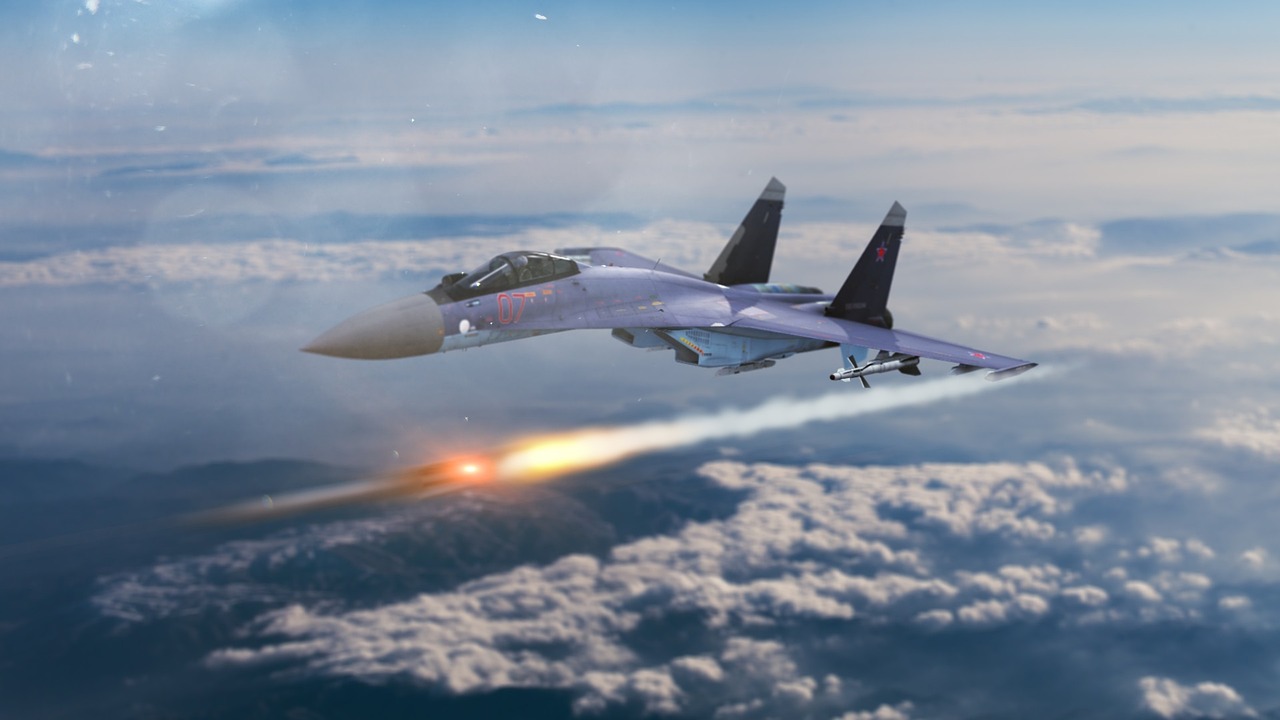
AI in Strategic Planning
In the realm of military operations, strategic planning is akin to a game of chess, where every move counts and foresight is crucial. Enter artificial intelligence, a game-changer that is reshaping how military organizations approach their long-term strategies. With the ability to analyze vast datasets and simulate various scenarios, AI provides military leaders with a powerful tool that enhances decision-making processes and optimizes resource management.
Imagine having a crystal ball that not only predicts potential outcomes but also evaluates the risks and benefits associated with each scenario. AI does just that by integrating data from various sources, such as historical operations, current intelligence, and even logistical considerations, to create a comprehensive picture of potential future states. This capability allows military planners to assess multiple strategies and their implications, ensuring that decisions are made based on robust data rather than gut feelings.
Moreover, AI's predictive capabilities extend beyond mere analysis. It can identify patterns and trends that may not be immediately apparent to human analysts. For instance, by examining past conflict data, AI can highlight which strategies led to success or failure under similar circumstances. This insight is invaluable, as it enables military leaders to refine their approaches and allocate resources more effectively. The result? A more adaptive and responsive military force that is prepared for the uncertainties of modern warfare.
To illustrate the impact of AI on strategic planning, consider the following table that outlines key benefits:
| Benefit | Description |
|---|---|
| Enhanced Decision-Making | AI provides data-driven insights, allowing leaders to make informed choices quickly. |
| Scenario Simulation | AI can simulate various operational scenarios, helping planners evaluate potential outcomes. |
| Resource Optimization | AI analyzes mission requirements and available assets to ensure efficient resource allocation. |
| Risk Assessment | AI identifies potential risks and suggests mitigation strategies based on historical data. |
As military organizations increasingly adopt AI technologies, the integration of these systems into strategic planning processes is becoming essential. By leveraging AI, military leaders can not only enhance their operational readiness but also create a more agile framework for responding to emerging threats. This shift towards data-centric decision-making is not just a trend; it represents a fundamental change in how military strategy is formulated and executed.
In conclusion, the future of military strategic planning is intertwined with the advancements in AI. As these technologies continue to evolve, we can expect even greater enhancements in efficiency, effectiveness, and security. The military will be better equipped to navigate the complexities of modern warfare, making informed decisions that can save lives and resources alike.
- How does AI improve decision-making in military planning?
AI analyzes large datasets to provide actionable insights, allowing military leaders to make informed decisions quickly. - What are the potential risks of using AI in military strategy?
While AI offers numerous benefits, there are concerns about over-reliance on technology, data security, and the ethical implications of automated decision-making. - Can AI replace human judgment in military operations?
No, AI is a tool that aids human decision-making but cannot fully replace the nuanced understanding and ethical considerations that human leaders bring to complex situations.

Future Trends in AI and Military Management
As we look ahead, the integration of artificial intelligence (AI) in military asset management is set to revolutionize the way defense operations are conducted. The future is bright, filled with innovative technologies that promise to enhance efficiency, effectiveness, and security. One of the most exciting trends is the development of autonomous systems. These systems are not just about drones anymore; they encompass a wide range of applications, from unmanned ground vehicles to AI-driven decision-making platforms that can operate independently in complex environments.
Moreover, the rise of machine learning algorithms will enable military organizations to analyze vast datasets more effectively. Imagine a system that can learn from past operations, adapt to new situations, and provide insights that were previously unimaginable. This capability will allow military leaders to make decisions that are not only faster but also more informed, significantly improving operational outcomes.
Another key trend is the increasing importance of real-time data analytics. In the heat of battle, having access to real-time information can mean the difference between success and failure. AI systems will be able to process information from multiple sources—satellites, drones, and ground troops—simultaneously, providing commanders with a comprehensive view of the battlefield. This will enhance situational awareness and allow for rapid responses to emerging threats.
Furthermore, the future of AI in military management will likely see a greater emphasis on collaborative AI. As military operations become more joint and coalition-based, AI systems will need to work together across different branches of the armed forces and even with allied nations. This collaboration will not only improve interoperability but also create a unified approach to tackling complex challenges.
Additionally, advancements in cybersecurity AI will be crucial as military assets become increasingly digital. With the rise of cyber threats, AI will play a pivotal role in identifying vulnerabilities and defending against attacks in real time. The ability to predict and counteract cyber threats before they can inflict damage will be a game changer for military operations.
Lastly, the ethical implications of AI in military management cannot be overlooked. As AI systems become more autonomous, the question of accountability arises. Who is responsible when an AI makes a decision that leads to unintended consequences? Future developments will need to address these ethical considerations, ensuring that AI is used responsibly and in accordance with international laws.
In conclusion, the future trends in AI and military management point towards a landscape that is not only more efficient but also more complex. As we embrace these changes, it is essential to strike a balance between leveraging technology and maintaining human oversight to ensure that military operations remain effective and ethical.
- What role does AI play in military asset management? AI enhances efficiency in inventory management, predictive maintenance, logistics optimization, and decision-making processes.
- How can AI improve military training? AI creates realistic training simulations that help military personnel develop their skills in a controlled environment, preparing them for real-world scenarios.
- What are the ethical concerns surrounding AI in the military? Ethical concerns include accountability for AI decisions, the potential for misuse, and ensuring compliance with international laws.
- Will AI replace human roles in the military? While AI will automate certain tasks, human oversight will remain crucial for strategic decision-making and ethical considerations.
- What is the future of AI in military operations? The future includes advancements in autonomous systems, real-time data analytics, collaborative AI, and enhanced cybersecurity measures.
Frequently Asked Questions
- How does AI improve inventory management in the military?
AI enhances inventory management by predicting supply needs and optimizing stock levels. This means military units can avoid overstocking while ensuring that essential assets are available when needed. Think of it as having a smart assistant that knows exactly when to order more supplies before they run out!
- What is predictive maintenance, and why is it important?
Predictive maintenance uses AI to analyze data from military equipment to predict potential failures before they happen. This proactive approach minimizes downtime and keeps military operations running smoothly. Imagine being able to fix your car before it breaks down—it's all about staying one step ahead!
- How does AI optimize logistics for military operations?
AI algorithms assess complex logistics networks to determine the best routes and delivery schedules. This ensures that supplies reach their destinations efficiently, saving time and resources. Picture a GPS that not only finds the quickest route but also adapts to traffic conditions in real-time!
- In what ways does AI assist in decision-making for military leaders?
AI processes vast amounts of data to provide actionable insights, enabling military leaders to make quick and informed decisions. It's like having a supercharged research assistant that filters through mountains of information to highlight what truly matters in a crisis!
- Can AI enhance training simulations for military personnel?
Absolutely! AI creates realistic training simulations that immerse military personnel in environments mirroring real-world scenarios. This hands-on approach boosts preparedness and sharpens decision-making skills, akin to a video game that trains you for real-life challenges.
- How does AI contribute to military cybersecurity?
AI enhances cybersecurity by detecting anomalies and potential threats in real-time, protecting sensitive military information. Think of it as having a vigilant security guard who never sleeps, always on the lookout for anything suspicious!
- What role does AI play in resource allocation for military operations?
AI analyzes mission requirements and available assets to optimize resource allocation. This ensures that military operations are conducted with maximum efficiency, much like a chess player strategizing moves to win the game!
- How is AI integrated into strategic planning for military organizations?
Integrating AI into strategic planning allows military organizations to evaluate various scenarios and outcomes. This helps improve long-term planning and resource management, similar to having a crystal ball that reveals the best paths forward!
- What are the future trends for AI in military asset management?
The future of AI in military asset management looks promising, with advancements that will further enhance efficiency, effectiveness, and security. As technology evolves, we can expect even smarter systems that will revolutionize defense operations!







